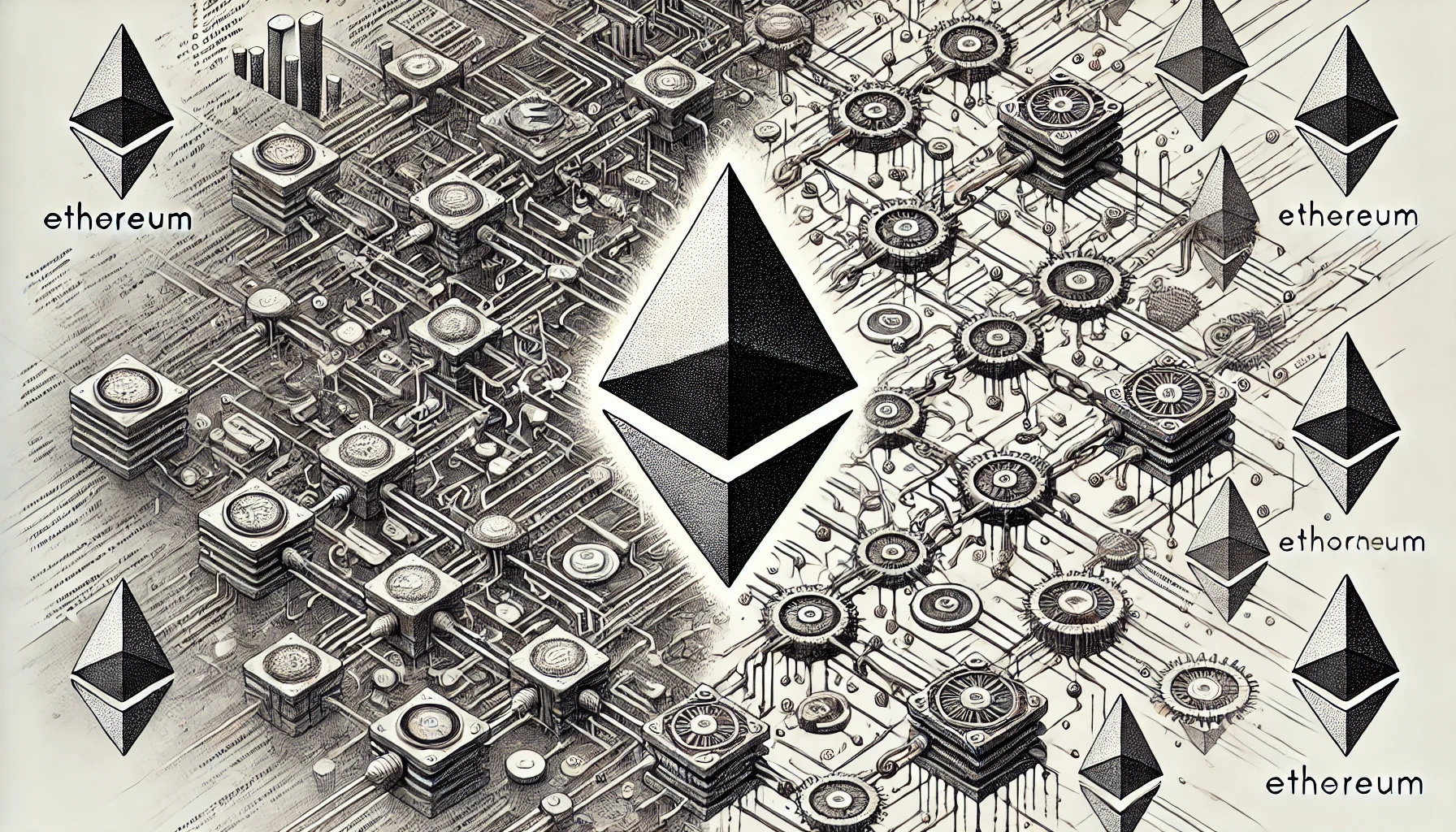In the world of blockchains, everyone wants three things: scalability, security, and decentralization. It’s kind of like the Holy Trinity, but for nerds and investors. Ethereum’s been at it for years, trying to balance these three without spilling their latte, while Solana’s like the new kid on the block with a hoverboard, whizzing around at lightning speed. But can Ethereum keep its crown, or will Solana zoom ahead and leave it in the dust? Let’s find out.
Ethereum’s Master Plan
Ethereum’s strategy is basically a full-on house renovation—they’re doing everything from moving walls (switching to Proof of Stake) to repainting the trim (scaling solutions). Let’s break down what they’re up to:
- Proof of Stake (PoS): The Merge—It Finally Happened Remember September 2022? Ethereum finally swapped out its old-school Proof of Work system—where mining was essentially a global heating contest—for Proof of Stake. Think of it as Ethereum quitting its energy-drinking habit cold turkey. The new PoS system is cleaner, greener, and kind of like getting fit enough to climb scalability mountain.
- Layer 2 Scaling Solutions: Rollups, Rollups Everywhere So Ethereum’s new approach is all about Layer 2—because apparently, Layer 1 was too mainstream. There are these things called rollups (no, not the fruit kind—though they’re just as sweet). Optimistic Rollups and Zero-Knowledge Rollups do the heavy lifting off-chain and then come back to Ethereum with the result, like a super productive intern. In addition to rollups, Ethereum is also exploring the concept of appchains. Appchains are customized Layer 2 chains designed for specific applications, providing greater flexibility and scalability tailored to particular use cases. By allowing certain applications to operate on their own specialized chains, appchains can reduce congestion on the main network while still benefiting from Ethereum’s security and decentralization.
- Sharding—Coming Soon-ish Imagine if instead of one person doing everything, you divided the work among 100 of your closest friends. That’s the idea behind sharding—Ethereum wants to split its workload to speed things up. It’s not here yet, but it’s coming, maybe around the time flying cars become a reality.
- Decentralization and Security—Bringing It Back Home Ethereum’s obsessed with making sure anyone with a decent internet connection can run a node. No supercomputers or Batcave required—they’re making it easier for regular folks to participate. Because if decentralization doesn’t include you and me, then who’s left?
Building a Moat
Ethereum is also possibly creating a robust moat. While blockchain tech is rapidly evolving, Ethereum’s focus on decentralized security and its extensive network effects are not easy to replicate. The more developers, users, and projects that join Ethereum, the harder it becomes for competitors to lure them away. This network effect makes Ethereum’s ecosystem a tough nut to crack, giving it a significant advantage despite the rapid pace of blockchain innovation.
Ethereum’s moat is built on a few key pillars:
- Developer Community: Ethereum has a head start, and thousands of developers are building decentralized applications (dApps) that enhance the value of the network. From DeFi protocols to NFTs, the diversity and maturity of the projects running on Ethereum are unmatched.
- Security and Decentralization: The network’s emphasis on security and decentralization means that users trust Ethereum to be the backbone of Web3. Unlike newer chains that may prioritize speed, Ethereum’s cautious approach ensures that major vulnerabilities are caught and addressed, keeping the network stable and reliable.
- Layer 2 Scaling Solutions: Ethereum’s Layer 2 scaling solutions are positioning it for mass adoption without compromising on decentralization. The investments in ZK-Rollups, Optimistic Rollups, and other scaling methods are creating a vibrant ecosystem where developers can choose how they want to balance cost, speed, and security—all within the Ethereum umbrella.
These aspects make Ethereum’s moat formidable, not just in terms of technology but also in community, developer support, and real-world applications. Solana and other blockchain contenders may be fast and exciting, but Ethereum’s depth and resilience are hard to beat.
Solana: The Speed Demon
Now let’s talk about Solana. It’s like that friend who decides they’re gonna run a marathon without stretching first—super fast, super cool, and maybe not thinking about the long-term consequences.
- Monolithic Architecture—All-in-One Blockchain Solana’s philosophy is “Why bother with Layer 2 when you can just make Layer 1 really, really fast?” Solana handles everything on one layer—kind of like juggling chainsaws, but doing it so quickly that people just cheer instead of worrying.
- Proof of History (PoH)—Time Travel, Anyone? Solana’s got something called Proof of History, which sounds like a time-travel device. It’s actually a way of timestamping transactions so that everyone knows what’s happening when. It’s fast. Blazing fast. But to keep up, you might need a NASA-level computer, which means not everyone’s invited to the party.
- Trade-offs—Decentralization, Who? Solana’s great at performance, but decentralization is a bit… meh. The network runs on powerful hardware that’s not exactly Raspberry Pi-friendly. So, it’s a little less “for the people” and a little more “for the data centers.”
The Big Assumptions Behind Ethereum’s Plan
Ethereum’s entire strategy is built on a series of critical assumptions, and these assumptions need to hold true for the plan to succeed. These assumptions include the successful adoption of Layer 2 solutions, maintaining security across Layer 2, effective implementation of sharding, and continued ecosystem support. Another big assumption is that blockchain technology will continue to evolve rapidly, and systems like Solana, which prioritize speed over adaptability, may quickly get outdated. Ethereum, on the other hand, can keep benefiting from Layer 2 innovations and its modular approach. If any of these assumptions falter, the entire strategy could face significant setbacks. Therefore, understanding these assumptions and ensuring they hold true is crucial for Ethereum’s future success.
- Layer 2 Will Save Us All: Ethereum thinks everyone’s going to flock to Layer 2, no questions asked. The idea is that Layer 2 solutions, such as Optimistic Rollups and Zero-Knowledge Rollups, will handle most of the transaction processing off-chain, significantly reducing the load on the main Ethereum chain. By doing this, Ethereum aims to achieve scalability without compromising decentralization or security. Users and developers are just supposed to get on board with the whole “off-chain is the new on-chain” vibe. These Layer 2 networks are designed to offer cheaper and faster transactions while still inheriting the security guarantees of Ethereum. Ethereum’s broader ecosystem is also investing heavily in improving user experience on Layer 2s, making it easier to switch back and forth between Layer 1 and Layer 2, integrating them seamlessly into wallets and dApps. The ultimate goal is to make Layer 2 transactions feel just as native and secure as Layer 1 transactions, giving users the benefits of scalability without the headaches of high fees or reduced security.
- Trust in Layer 2 Security: Ethereum’s assuming that Layer 2 solutions will continue to need Ethereum to secure themselves. This assumption hinges on the fact that these Layer 2 solutions rely on Ethereum’s main chain for their security guarantees, including cryptographic techniques like Zero-Knowledge Proofs, which ensure that off-chain transactions are verified without compromising data integrity. Security in Layer 2 also involves Byzantine Fault Tolerance (BFT), where the system must be resilient even when some nodes act maliciously or fail. L2s depend on Ethereum to provide security and practical Byzantine Fault Tolerance, leveraging the main chain’s security guarantees to ensure that they remain resilient to attacks.
- Sharding Will Work—Someday: Sharding is still in the oven. Ethereum’s betting big that when it’s done, it’ll not only work, but enhance the network’s scalability without compromising decentralization or security. Sharding will partition the blockchain into multiple shards, each capable of processing its own transactions and smart contracts. This reduces the workload on the main chain, allowing it to handle more transactions in parallel, which significantly increases throughput. However, ensuring that the shards can communicate effectively and maintain the overall security of the network is crucial. Sharding also introduces challenges related to cross-shard communication and data availability, but if implemented correctly, it will help Ethereum scale while keeping the network decentralized and secure.
- Ecosystem Will Keep Showing Up: The developers, the users, the stans—everyone needs to keep coming back and building for this whole plan to work. Ethereum’s success depends heavily on its community’s continuous engagement. The developers need to keep innovating, creating new dApps, and improving the infrastructure. Users need to stay loyal and keep utilizing the network, contributing to its growth. This kind of sustained participation ensures that the ecosystem thrives, new projects are launched, and the network effects are strengthened. The commitment of developers and users is what makes Ethereum resilient, adaptable, and capable of taking on future challenges. Without an active and engaged community, even the best technical upgrades would fall short.
The Big IFs: What Needs to Happen?
- Layer 2 Must Move Faster: Layer 2 solutions need to move and scale faster than Solana. The competition is fierce, and if Ethereum’s L2s can’t outpace Solana in terms of speed and scalability, then the entire strategy could falter. Ethereum’s L2 ecosystem needs to demonstrate not only the security and decentralization advantages but also the capability to match or exceed Solana’s performance in handling transactions.
- Ease of Use: Layer 2 solutions need to be easy to use. Like “grandma sending an email” easy, not “nuclear reactor control” easy. Integration into wallets and dApps has to be seamless so that users don’t feel the complexity beneath the surface.
- Security: Security audits for Layer 2 must be solid. No one wants to wake up and find out the network got robbed. The track record of Layer 2 security has to be almost spotless to gain the trust of users and developers alike.
- Bug-Free Sharding: Sharding has to roll out without any embarrassing bugs. The technical complexity of sharding is immense, and any missteps could harm the reputation of the network or even compromise its security.
- Community Engagement: Community’s got to stay hyped. Ethereum has a strong community, but it needs to stay engaged and excited. No community, no updates, no party.
Past Adventures in Scaling—What Did We Learn?
- Bitcoin’s Lightning Network: It’s a great idea—until you realize it’s a bit finicky, like trying to make a call on a flip phone in 2024. It works, but not everyone loves using it.
- Ethereum Increasing Block Size/Gas Limit: This is like trying to fix rush hour by making the highway lanes wider. It helps, but eventually, more cars just show up, and you’re back to square one.
- Other Layer 1s (EOS, Binance Smart Chain): They got speed by centralizing, but blockchain purists screamed “Foul!” Performance good, decentralization bad—it’s a tough balance.
- Sharding in Databases: Sharding works in databases. You know, the kind of places where you don’t have thousands of people trying to double-spend a pizza. On blockchain? Different ballgame.
Conclusion—Or Is It Just the Beginning?
Ethereum’s trying to juggle security, scalability, and decentralization like a professional circus performer, while Solana’s speed-running it with one of those “YOLO” attitudes. Both strategies have their perks, both have their problems, and both are banking on different futures for blockchain tech.
One thing’s for sure—as blockchain enthusiasts, we’re here for the ride, whether Ethereum becomes the modular master of scalability or Solana keeps zooming ahead until it hits some sort of wall. Place your bets, grab your popcorn, and remember—in the blockchain world, the only constant is that everything’s always changing.
Let me know which blockchain you’re rooting for in the comments below—are you with Ethereum, or are you hopping on Solana’s rocket ship?


Comments
One response to ““Ethereum vs Solana: The Battle of the Blockchains – Scalable, Secure, or Just Out of Breath?””
Hi, this is a comment.
To get started with moderating, editing, and deleting comments, please visit the Comments screen in the dashboard.
Commenter avatars come from Gravatar.